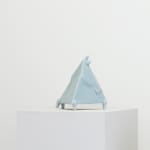Suzuki Osamu (1926−2001)
Horse: Into a Form of Triangle
Sealed “Su” on the back
With a box signed by the artist
W23.6 x H24.5 cm
With a box signed by the artist
W23.6 x H24.5 cm
Further images
Exhibitions
Solo Show. Tokyo: Shinjuku Isetan, 1978.Suzuki Osamu: Image in Clay. Kyoto: The National Museum of Modern Art, Kyoto; Seto: Aichi Prefectural Ceramic Museum; Tokyo: Tokyo Station Gallery; Hagi: The Hagi Uragami Museum, 2013-14.
Two feet stretch out from two pointed ends at the bottom of a tetrahedron, symbolizing the front legs; the other two feet extend from the remaining end as the rear legs and the buttocks. On the top of the trigonal pyramid a pair of ears sticks out, and the elongated ridge line descending from the top divides into two planes, creating a horse’s profile one side and its mane the other. Entitled the work Horse: Into a Form of Triangle, Suzuki Osamu proposes himself a question of how a creature like a horse being transformed into a geometrical form, a triangle. A pose of a gentle kick of single rear leg imparts a sense of rhythm.
A tetrahedron, the four-triangular-face body, is comprised of least points, lines, and planes. In such a minimalized, three-dimensional object, Suzuki attempts to create a horse with the vigorous and graceful lines, proving that as a ceramist, who is eager to reproduce natural subjects by artificial means, Suzuki is ambitious of making his own arts. “Clay is a form of reduction, stone is a form of addition,” once stated Suzuki. Here, “clay” indicates the red-clay stoneware work, and “stone” means the bluish-white glazed porcelain one. Back to the present work, two contrary elements: organic and geometric, which are deftly implemented through adding, are superlatively demonstrated here.
Suzuki Osamu (ceramist; 1926−2001)
Kyoto-born ceramist. Established an avant-garde ceramist group Sodei-sha with Yagi Kazuo, Yamada Hikaru, and others. Played an innovative role and breathed fresh air into Japan’s contemporary ceramic field. Received awards from the Japan Ceramic Society, Asahi Ceramic Art Exhibition, and many others in and out of Japan. Appointed Kyoto City University of the Arts professor.
A tetrahedron, the four-triangular-face body, is comprised of least points, lines, and planes. In such a minimalized, three-dimensional object, Suzuki attempts to create a horse with the vigorous and graceful lines, proving that as a ceramist, who is eager to reproduce natural subjects by artificial means, Suzuki is ambitious of making his own arts. “Clay is a form of reduction, stone is a form of addition,” once stated Suzuki. Here, “clay” indicates the red-clay stoneware work, and “stone” means the bluish-white glazed porcelain one. Back to the present work, two contrary elements: organic and geometric, which are deftly implemented through adding, are superlatively demonstrated here.
Suzuki Osamu (ceramist; 1926−2001)
Kyoto-born ceramist. Established an avant-garde ceramist group Sodei-sha with Yagi Kazuo, Yamada Hikaru, and others. Played an innovative role and breathed fresh air into Japan’s contemporary ceramic field. Received awards from the Japan Ceramic Society, Asahi Ceramic Art Exhibition, and many others in and out of Japan. Appointed Kyoto City University of the Arts professor.









